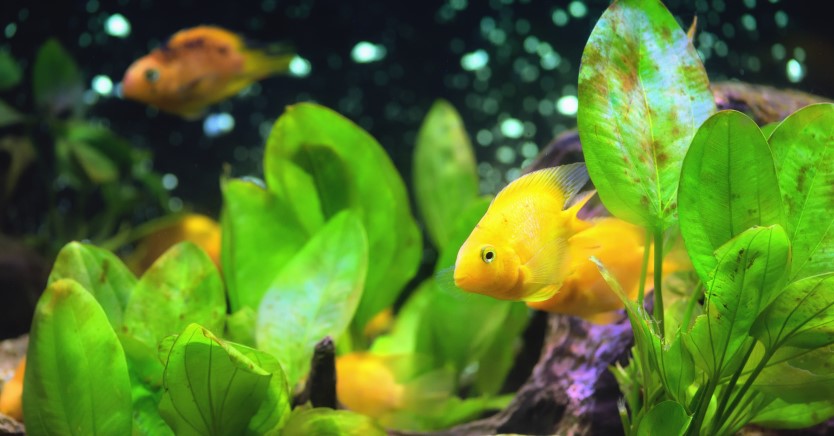How to Keep Your Aquarium Cool in the Summer Heat
Summer temperatures can cause aquarium temperature to rise but there are ways to cool down the water for healthier fish.

Heat waves in the summer can be tough on fish, especially if you have limited or no air conditioning in your home to keep the tank water cool. When the indoor temperature rises, so does the temperature of the water. When water warms up, it holds less oxygen, causing the metabolism and breathing of fish to speed up. This can stress out your aquatic friends and make them more susceptible to illness and disease.
While you can’t control the temperature outside, you can take some important steps to cool down your aquarium water in the summer.
Remove All Unnecessary Heat Sources
If the water in your aquarium is too warm, start by removing all heat sources on and near the tank. This includes any heaters, skimmers, UV sterilizers, and even lights that tend to get hot. Any device that uses electrical power has the potential to get warm, which can contribute to the overheating of aquarium water.
If you need a light source, switch to an option that doesn’t produce warmth. In addition, consider a sponge filter with a non-heat-producing air pump over a canister filter.
Introduce Fans
In the same way that you’d use a fan to cool yourself down, you can place fans strategically around your aquarium to cool down the water. Placing fans so that the airflow skims across the surface of the water helps with water evaporation and gradually cools down the water temperature.
Unless you have fish that tend to jump out of the tank, consider removing the top of the aquarium to allow heat to escape and for overall better ventilation. Choose a fan that is relatively quiet to avoid stressing the fish.
Move the Aquarium to a Cooler Area of the Home
If certain parts of your home are warmer than others, it may be necessary to move the fish tank to another area of the home where it’s cooler. For example, if the tank is currently in the living room where there is no air conditioning, move it to a bedroom where there is AC and a cooler environment.
Also, consider the placement inside the room. Avoid putting an aquarium in direct sunlight as this can quickly heat up the water. Also, move the tank away from any appliances that produce heat, such as dryers, ovens, and even gaming systems that may blow out hot air.
Invest in an Aquarium Chiller
An aquarium chiller is essentially a box that is separate from your fish tank and works to lower the temperature of the water. They operate by circulating the aquarium water to make it cooler and prevent the consequences of heat waves.
Chillers work similarly to canister filters to gain better control of water temperature. An aquarium chiller sits right outside the tank and contains two hoses that go from the chiller to the aquarium. Water from the tank flows through one hose into the chiller, where it is cooled before being directed into the other hose and back into the tank.
Surround the Fish Tank with Reflective Insulation
Although it may seem counterproductive to cover the fish tank when the indoor temperature is so high, using the right materials can actually help keep the water cool. In a severe heat wave, cover the back and two side walls of the aquarium with the proper insulation material, such as double reflective insulation or sheets of Styrofoam.
Foil-colored bubble wrap can also be useful in helping to reduce the aquarium water temperature by a few degrees. Choose an insulation that is lightweight and avoid covering the front of the tank unless there is a heat-related emergency.
Use an Air Stone (Aquarium Bubbler)
Air stones, otherwise known as aquarium bubblers, are a common type of tank supply that works by gradually diffusing air into the aquarium. They are often used instead of conventional air filtration systems which can be loud and create large bubbles. Air stones can also be useful for helping to keep the water in your fish tank cool.
When the air stone creates bubbles, it causes surface agitation which encourages gas exchange. As warm water tends to hold less dissolved oxygen compared to cooler water, adding an air stone to the tank can create enough turbulence to reduce the risk of oxygen depletion.
Continue to Monitor the Water Temperature in the Tank
During the summer, it’s important to keep a good eye on your aquarium’s water temperature to ensure that it doesn’t get too hot. Use a reliable digital monitor or quality thermometer to monitor any changes from one day to the next.
If you see that the water temperature is starting to climb, utilize the necessary techniques to cool it down before it reaches dangerous levels. Some aquarium thermometers have built-in alarms that give audible signals when the water gets too hot or cold.
Keeping Your Aquarium Water Cool in the Summer
During the summer months, especially when heat waves occur, your fish are at risk of illness, disease, and even death. Creating a cool and healthy aquatic environment includes maintaining a cool temperature that is not too hot or too cold. By taking these extra precautions, you can extend the longevity of your pet fish and keep your tank inhabitants healthy.
Ready to start saving money on pet wellness care?
Then take a look at Mint Wellness, the pet wellness plan that provides fast reimbursement on routine pet care. Save on vaccinations, wellness exams, preventatives, dental, and more!
Learn More